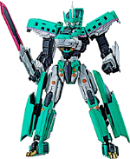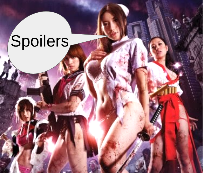
|
This article is under construction.
(October 8, 2020) |
|---|
| Godzilla vs. Space Godzilla | |
|---|---|
| [[Image:Godzilla vs. SpaceGodzilla (1994) Main Japanese Poster.jpg|200px|]] | |
| Directed by | Kensho Yamashita (Main story) Koichi Kawakita (SFX) |
| Produced by | Tomoyuki Tanaka (Executive) |
| Music by | Takayuki Hattori Akira Ifukube (Godzilla) |
| Running time | 108 minutes (Japan) |
| Budget | 2.81 billion Yen |
Godzilla vs. SpaceGodzilla (also known as Godzilla vs. SpaceGodzilla) is a 1994 toho action film,Directed by Kensho Yamashita.
Plot[]
|
|
SPOILER WARNING: This section may contain major plot and/or ending details. Proceed at your own discretion. |
|---|
Center as a countermeasure against Godzilla. "M project" and "T project".
On Bath Island in the South Pacific Ocean, Akira Yuki, a member of G Force who is obsessed with overthrowing Godzilla, is fond of Little Godzilla, a grown-up figure of Baby Godzilla, but has various traps to defeat Godzilla. I was preparing steadily. Koji Shinshiro and Kiyoshi Sato, who visited Bath Island to support the T project, discover a strange group of crystals standing in the center of the island . Meanwhile, Miki Saegusa, the chief of the Psychic Center , receives an ominous message from the small beauty Cosmos who has turned into a fairy Mothra .
When G-Force was excited about the completion of the new weapon MOGERA, a huge space monster was approaching the earth from beyond the universe at a tremendous speed. Its true identity was Space Godzilla, a space monster born from G cells that once scattered into space. The T project was started on Bath Island, where Miki arrived, but it ended in failure due to an accident of unknown cause.
Space Godzilla, who easily defeated MOGERA who went out to intercept and landed on Bath Island, overwhelmed Godzilla and confined Little in a crystal, attacked various parts of Japan and landed in Fukuoka. At that time, Miki was abducted by the guidance of Dr. Okubo, who was in charge of the T project but was colluding with the mafia organization behind the scenes. After returning to Japan, Shinshiro and his friends destroy the mafia organization and rescue Miki. Soon, MOGERA, who was renovated and strengthened to intercept Space Godzilla, and Godzilla, who has moved northward in Kyushu after landing from Kagoshima Bay , will face each other in Fukuoka.
Cast[]
- Koji Shinjo: Jun Hashizume
- Miki Saegusa: Megumi Odaka
- Kiyoshi Sato: Zenkichi Yoneyama
- Commander Takaki Aso: Akira Nakao
- Shin Okubo: Yosuke Saito
- Iwao Hyodo: Koichi Ueda
- Takayuki Segawa: Kenji Sahara
- Yuzo Suzuki: Hiroshi Miyasaka
- Moguera Pilot: Houka Kinoshita
- Alexander Mamilov: Ronald Hair
- Eric Gould: Ed Saadi
- Frank Reynolds: Eddie Quinnlan
- McKay: Tom Dolan
- Makoto Uehara: Jin Kusanagi
- Masato Wakatsuki: Taro Horisaki
- Michiya Kato: Izumisaburo Makimura
- Police officer: Shinji Nasu
- Reporter: Miho Araki
- G Force members: Yutaro Mitsuoka , Isao Shinohara , Kenichi Kohei , Ryohisa Hattori , Hideyuki Umeda , Yohei Osawa , Isao Yamazaki , Hisayoshi Izaki , Zengoro Tanuki
- Yamanoue Hotel (Fukuoka) Residents : Muranaka Tomomi
- Companies mafia man: Charlie class love skiing , Robert Santana , Shinichi Shimizu
- Astronauts: Frank O'Connor , Andy Smith , Maxine Marchgevic
- Adjutant: Kanji Watanabe , GAZ
- Office worker boss : Kazuki Kosakai
- Office worker subordinate : Kunihiro Matsumura
- Cosmos: Keiko Imamura , Sayaka Osawa
- Chinatsu Gondo: Towako Yoshikawa
- Major Akira Yuki: Akira Emoto
Staff[]
- Production- Tomoyuki Tanaka
- Co-production- Shogo Tomiyama
- Screenplay- Hiroshi Kashiwabara
- Shooting- Masahiro Kishimoto
- Lighting- Hideki Mochizuki
- Art- Tadashi Sakai
- Recording- Kazuo Miyauchi
- Effect-Hideyo Sasaki ( Oriental Acoustics )
- Edit --Miho Yoneda
- Assistant Director- Kunio Miyoshi
- Music- Takayuki Hattori
- Godzilla theme song- Akira Ifukube
- Producer- Toshiro Tokumasu
- Production Assistant- Shinichiro Arimasa
- Associate Producer-Ritsuko Suzuki
- Special technology
- Shooting- Kenichi Eguchi , Fujio Okawa
- Art- Tetsuzo Osawa
- Lighting- Kaoru Saito
- Special effects- Tadaaki Watanabe
- Modeling- Tomoki Kobayashi , Shinichi Wakasa
- Performance-Kazuo Mihashi
- Assistant Director- Kenji Suzuki
- Producer- Taro Kojima
- Godzilla- Kenpachiro Satsuma
- Little Godzilla- Little Frankie
- Space Godzilla- Ryo Hariya
- MOGERA- Wataru Fukuda
- Sponsored by- Seiyu , Best Denki , Konica , JOMO , Oshima Transport
- Production cooperation- Toho Visual Art , Toho Sound Creative Studio, Toho Music, Tokyo Laboratory, Toho Studio
- Special Skill Director- Koichi Kawakita
- Director- Kensho Yamashita
- Toho movie work
- Distribution- Toho
Titles[]

|
Stub |
Overview[]
Originally , the series was supposed to end once with the previous work " Godzilla vs. Mechagodzilla ", but it was a work that was produced in a hurry because the production of the Emmerich version of Godzilla was delayed . The main staff of the previous work was in the shooting of " Yamato Takeru " at that time, and new main story staff and planning staff who had no experience of the Heisei VS series such as director Kensho Yamashita and scriptwriter Hiroshi Kashiwabara are participating .
Five monsters appear, which is the largest number in the Heisei VS series . In addition, Mothra (adult), Battra (adult), and Biollante (food form) have appeared in live films .
Basically, it is made with more entertainment than realism , and there is also a love drama between Koji Shinshiro and Miki Saegusa and a revenge drama for Akira Yuki's Godzilla. Another highlight is that the scenery of Bath Island colors the faint love. Unusual for the Heisei Godzilla series, Godzilla is drawn a little closer to humankind, and the feature is that Godzilla is treated like a hero only in this series (actually, the little rescue confined in the crystal) Fighting for). In the decisive battle with Space Godzilla in Fukuoka, Godzilla and G Force robot MOGERA eventually set up a joint front.
The main attack points are Kagoshima , Kumamoto , Befu , and Fukuoka . This work was also talked about as Godzilla 's first landing in Kyushu . In addition, Sapporo , Yamagata , Kobe, etc. became prey to Space Godzilla.
Initially, a work was planned that welcomed King Ghidorah, a space super monster with the original setting, which is different from King Ghidorah that appeared in " Godzilla vs King Ghidorah ", but it will appear in " Yamato Takeru " released just before. Since Yamata no Orochi resembled Ghidorah, the plan was changed to a new Godzilla-type monster . When the production was decided, the idea was to continue throwing Mechagodzilla from the previous work , but it was decided to be Moguera with the opinion of Koichi Kawakita's special skill director "It's the same boring" (Kawakita wanted to put out Mechani-Kong , but dissenting opinion It was said that there were many). [ Citation needed ]
The theme song "ECHOES OF LOVE" ( Date of Birth ), which is the only theme song in the Heisei vs. series, was created by the intention of director Kensho Yamashita .

concept art of SpaceGodzilla

Late concept art of SpaceGodzilla
Production[]
Although director Kensho Yamashita and screenwriter Hiroshi Kashiwabara had more experience in producing teen idol movies, they were not newcomers to the kaiju genre, having both assumed minor roles in the making of Terror of Mechagodzilla. The two decided early in production to make the film more lighthearted than its predecessors and more focused on character development, centering it on Megumi Odaka's recurring character Miki Saegusa, who had previously played marginal roles in the series. The emphasis on lightheartedness was such that a scene depicting Godzilla desperately trying to rescue his son from SpaceGodzilla's crystal prison was deleted on account of its seriousness, a move disapproved of by Godzilla suit actor Kenpachiro Satsuma.
The idea of a "Space Godzilla" was first conceived in 1978, and was designed as a homage to the monster's hinted progenitor Biollante by incorporating tusks and a hissing roar reminiscent of the latter monster. Creature designer Shinji Nishikawa had initially envisioned SpaceGodzilla as a much more western dragon-like creature with large fin-like wings on the back. The final design bore greater resemblance to Godzilla's final form from the video game Super Godzilla, itself also designed by Nishikawa. Effects artist Koichi Kawakita redesigned Godzilla's son as a more cartoonish-looking character, having disliked the more dinosaurian-looking version in Godzilla vs. Mechagodzilla II. It was rumoured that Kawakita intended to use the new design in a children's spinoff TV special entitled Little Godzilla's Underground Adventure. However, this was nothing more than a myth. The M.O.G.U.E.R.A. suit was worn by Mechagodzilla performer Wataru Fukuda, and consisted of three pieces applied separately. The new Godzilla suit used for the majority of the film combined aspects of the suits used in Godzilla vs. Biollante/Godzilla vs. King Ghidorah and Godzilla vs. Mechagodzilla II, having a stocky, triangular build, wide shoulders and much less pronounced ribbing on the neck. The face bore similarities to those used in the previous two films, though the eyes were increased in size and given more prominent whites, thus making it relatively less menacing looking than its predecessors. Innovations included the head's ability to fully rotate around the body, and the incorporation of an air duct which solved the chronic ventilation problems present in previous suits. The suit from Godzilla vs. Mechagodzilla II was reused for Godzilla's entrance and exit from Birth Island and during the scene where he is telekinetically tossed by SpaceGodzilla.
Composer Akira Ifukube refused to be involved in the film after reading the script, which reminded him too much of a teen idol film and included rap music.

Early Concept art for MOGERA And SpaceGodzilla
Drafts[]
Godzilla vs. NeoGodzilla[]
(ゴジラVSネオゴジラ Gojira tai Neogojira) Submitted to Toho on January 29th, 1994 and written by the author responsible for Godzilla vs. Biollante (1989), Shinichiro Kobayashi's Godzilla vs. NeoGodzilla would be the first script to introduce the idea of a "crystal life" space organism versus "organic life". This theme, coupled with the idea of a final battle featuring a monster extremely close to Godzilla in design, would become highly influencial in all future drafts. While details regarding this lost project are scarce, keywords such as "crystals" and "Godzilla cells" are prevalent throughout the story.
Godzilla vs. AstroGodzilla[]
After Emperor Ghidorah was discarded as Godzilla's enemy for the sixth Heisei film, Toho continued to pursue an extraterrestrial foe for the King of the Monsters. This time, the antagonist was to be a clone of Godzilla himself, born from G-cells carried into outer space. This concept was considerably more ambitious than the final product would be, featuring an army of giant alien dragonflies controlled by AstroGodzilla and Mothra as Godzilla's ally along with MOGUERA. Shinichiro Kobayashi, writer of Godzilla vs. Biollante's original story, submitted a draft which built on this concept, though it made Godzilla's alien clone, now dubbed Crystal Godzilla, crystalline in origin. This eventually led to Godzilla vs. SpaceGodzilla.
Release[]
English Version[]
After the film was released in Japan, Toho commissioned a Hong Kong company to dub the film into English. In this international version of the movie, an English title card was superimposed over the Japanese title, as had been done with the previous 1990s Godzilla films.
Columbia TriStar Home Entertainment released Godzilla vs. SpaceGodzilla and Godzilla vs. Destoroyah on home video on January 19, 1999. This was the first time either film had been officially released in the United States. TriStar used the Toho dubs, but cut the end credits and created new titles and opening credits for both films. Toho's complete international version of Godzilla vs. SpaceGodzilla (sans any onscreen text besides the English title) has been broadcast on several premium movie channels since the early 2000s, as well as the 2014 Blu-Ray release.



